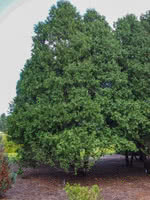Mon-Fri 9am - 5pm Mountain time
Eastern White Cedar (Arborvitae) vs Alpine Currant
Thuja occidentalis
Ribes alpinum
NOT AVAILABLE THIS SEASON - MIGHT RETURN
Eastern White Cedar is a slender growing conifer often used as a decorative tree or a hedge. This tree is an effective privacy screen even in winter and a great long term solution to urban crowding or a drab yard.
Alpine Currant is a great shrub to plant along sidewalks, near building or at your property boundary as a hedge or accent species. It is widely used by commercial landscapers in parking lots and near buildings because of its hardiness, attractiveness, and pollution tolerance.
While Alpine Currant produces edible berries, they are not palatable.

